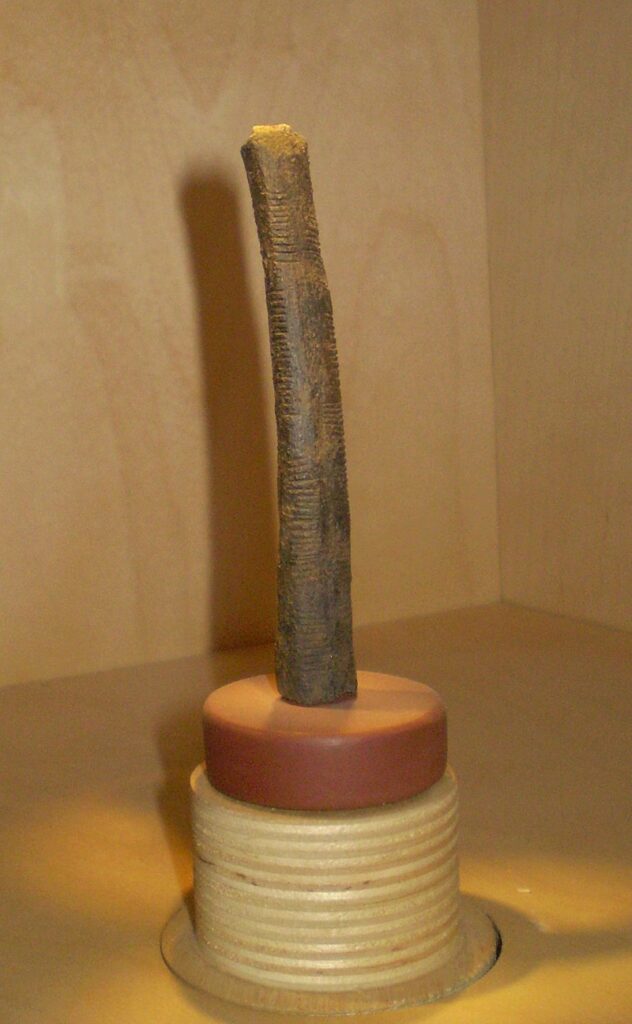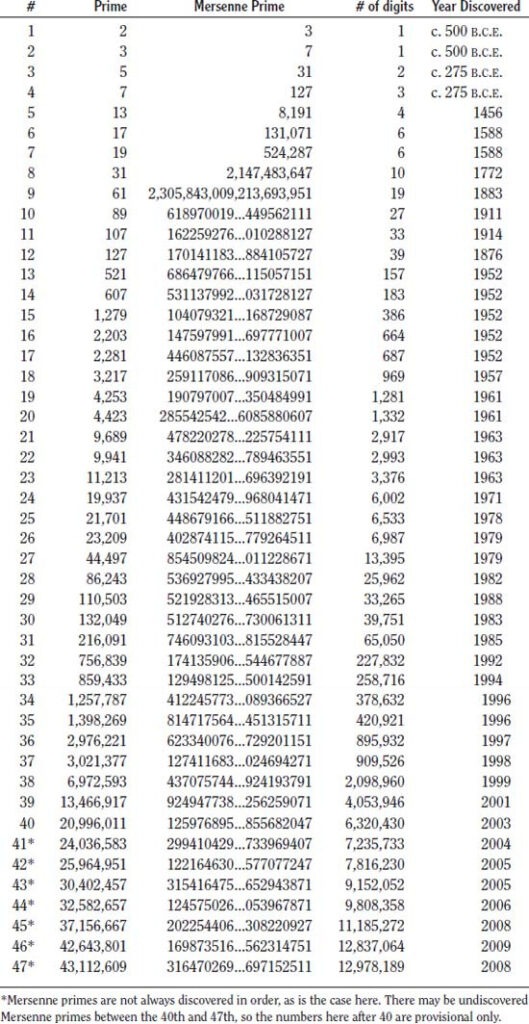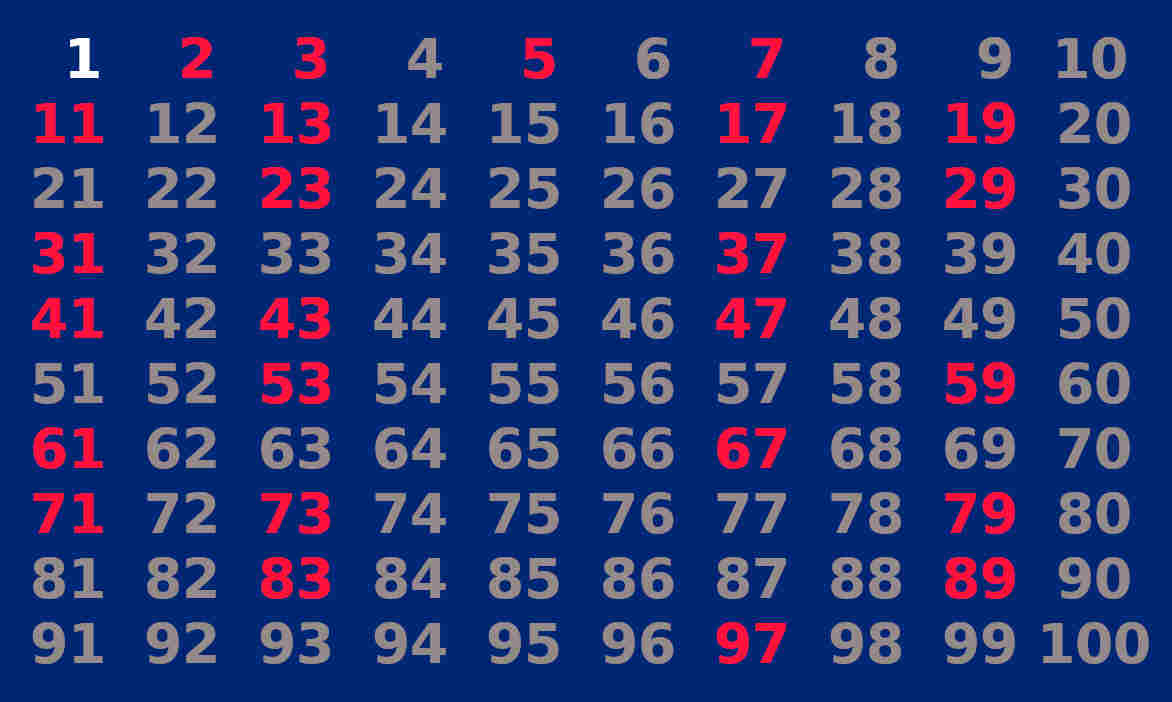Prime numbers are natural numbers greater than 1 and have the particularity that they are divisible only by themselves and unity and are important in mathematics not only because of such a singular nature but because of the fundamental theory of arithmetic that states the following:
“Any integer greater than 1 is either a prime number or any number that can be expressed as the multiplication of prime numbers.”
Euclid’s Elements. more than 2000 years ago. Tested by Gauss in 1801.
Some Curiosities of Prime Numbers
Prime numbers have many particular aspects that should not be overlooked:
- The first 10 prime numbers are 2, 3,5,7,11,13,17,19,23,29 and only the first prime number(2), is an even number and the following prime numbers are odd.
- All prime numbers except 2 and 5 always end in 1, 3, 7, or 9.
- Any even number can be expressed as the sum of two prime numbers.
- Any prime number other than 2 is the difference of the squares of two positive integers.
- All prime numbers other than 2 will always follow the pattern of 4n+1 or 4n-1, where n is a natural number.
- There are numbers that look like prime numbers but are not. The numbers: 333331.3333331,33333331 are prime numbers, but the number 333333331 is not.
- The number 73939133 is a prime number, so is 7393913, 739391, 73939, 7393, 739, 73, and 7.
- Prime numbers are known to be infinite, but the difference between one prime number and the next in the sequence becomes increasingly large when the prime number sought is higher in quantity.
- The conjecture of twin primes, are a pair of prime numbers that are differentiated by 2, Apparently there are infinite twin prime numbers the first pairs are 3 and 5, 5 and 7, 13 and 11, but as you look for the larger primes, twin primes are rarer.
- The sequence of prime numbers is random in nature, which is why they are used in cryptography.
- Prime numbers can be the basis of communication with advanced non-human societies, because of their unique characteristics and because they require an advanced knowledge of mathematics, sufficient so that when they become signals they can be recognized as an intelligent pattern.
- So far the longest known prime number is: 282,589,933 − 1
- There are illegal prime numbers, the following number:
The above is an illegal number, exactly an illegal prime number, in reality it is a program any computer program, it is a collection of 0 and 1, but it can be represented in any numerical system, here in decimal system, but the hexadecimal system is actually used for programming purposes, the number of the link is the encoding of the program of the year 2001 that corresponds to a compressed version of a program written C that decrypts commercial DVD content, which is a violation and illegal to distribute in the United States. Years later it was discovered that this number is a prime number, and it was one of the longest known prime numbers.
There will always be more curiosities about prime numbers, so present in mathematics but even so, they have properties unknown until now.
Prime Numbers in History

Surely in the empires of ancient China, Babylon, Sumeria or ancient Egypt or the Mayans have already noticed prime numbers and even studied them for their peculiarity, in fact, 20000 years ago in the Congo, a bone dated to more than 20000 years ago was found with a set of prime numbers (11, 13, 17, 19) marked, they are all prime numbers, there is no more information about it, it is believed that it may be a coincidence, but that hypothesis does not make much sense since the bone emphasizes a combo of prime numbers that cannot be attributed to randomness, since it adds 60, a number widely used in many peoples of the past, This shows an understanding of the set of prime numbers since that time. The Egyptians frequently worked with fractional numbers, the expression 2/n, was written as sums of numbers of the form 1/m+1/k, where m and k were non-repeating numbers and were prime numbers. The Chinese formulated a rather curious hypothesis, some claim that it could have been 2000 years ago or in the nineteenth century, whatever the case may be, the hypothesis warns that a number n is prime if and only if it satisfies the condition that 2n – 2 is divisible by n.
The classical Greek mathematician extensively studied prime numbers and their properties, The criva of Erastothenes is an algorithm that can calculate prime numbers within a selected range by following specific steps. Euclid in his work “Elements”, Book IX, proved that prime numbers were infinite as well as established the fundamental theorem of arithmetic, not only that, but showed that the number 2n – 1(Mersenne numbers) is prime when the number 2n-1 (2n – 1) is a perfect number.
Unfortunately there were no major advances in the study of prime numbers in medieval times in Europe, but if in the Islamic civilizations, in the Koran there are references to prime numbers, the first chapter is composed of 7 verses or verses, 29 words and 139 letters, all prime numbers, the Muslim mathematicians preserved the knowledge of the Greeks in various subjects, including prime numbers, for example: Ibn al-Banna managed to improve Erastothenes’ algorithm.
It wasn’t until the 18th century that many advances in number theory were made, Fermat proved Albert Girard’s conjecture, where every number of the form 4n+1 can be written as the sum of two squares as well as proving that any number can be written as the sum of 4 squares. Since that time many properties, theorems, conjectures or propositions have been created around prime numbers, yet many propositions and conjectures remain unscrambled, which constantly feeds humanity’s fascination with prime numbers.
Mersennes Prime Numbers
They are numbers extensively studied by Marin Mersennes, a 17th-century friar, and are characterized by the form Mn=2n-1 for an integer n. Numbers of this form were already known in ancient times in various cultures because of their relationship with perfect numbers (a perfect number is a number equal to the sum of its divisors, an example is 6, since it is equal to the sum of its divisors. 6=1+2+3). In Euclid’s theorem he established that 2p-1 is a prime number so 2p − 1(2p − 1) is perfect number, in fact all perfect numbers have that form, something already confirmed by Euler, that is why the theorem is known as the Euler-Euclid theorem. The existence of any odd perfect number is a mystery.
In mathematics we already have prime numbers (numbers with two divisors, 1 and the same number) and composite numbers (numbers that have more than two divisors. Example: 14 is a composite number because it has three divisors: 7, 2, 1). If we apply n to Mn=2n-1, we would get all possible Mersennes numbers, prime or compound, but the important thing is the Mersennes primes. In that case, there are two conditions to be Mersennes primes:
1.For Mn=2n-1, n must be a if or if a prime number.
2. Mn must be a prime number as well.
Under these conditions, the set of Mersennes primes is considerably reduced:

Various Conjectures with Prime Numbers
1.Conjecture of prime twin numbers: There are infinitely many pairs of prime numbers of the form p and p+2, where p is a prime number.
2.Goldbach’s conjecture: Every positive number greater than 2 can be written as the sum of two prime numbers.
3.Conjecture n2+1: There are infinite prime numbers of the form n2+1, where n is a positive integer.
4.Polignac conjecture: For every even number 2n there are infinitely many pairs of consecutive numbers that differ by 2n
5. Opperman conjecture: There will always be a prime number between n2 and (n+1)2
6.Waring’s conjecture: Any odd integer that exceeds 3 is a prime number or the sum of three prime numbers.
7.Andrica conjecture: It has to do with the difference of prime numbers, the following inequality represents the conjecture:
√(pn+1) – √(pn) < 1
La diferencia aritmética de la raíz cuadrada de un numero primo menos la raíz cuadrada de otro numero primo que le antecede es siempre menor que 1




قنوات الألياف البصرية يقدم مصنع إيليت بايب في العراق قنوات الألياف البصرية المصممة لحماية وإدارة كابلات الألياف البصرية بدقة. تم بناء قنواتنا لضمان الحد الأدنى من فقدان الإشارة وأقصى حماية ضد التلف المادي والعوامل البيئية. مع التركيز على الحفاظ على الأداء العالي والموثوقية، تعتبر قنوات الألياف البصرية الخاصة بنا ضرورية للبنى التحتية الحديثة للاتصالات. معروفون بالتزامنا بالجودة، يعد مصنع إيليت بايب أحد أكثر المصانع موثوقية في العراق، حيث يقدم قنوات تلتزم بالمعايير الدولية. اكتشف المزيد عن منتجاتنا على elitepipeiraq.com.
Your article helped me a lot, is there any more related content? Thanks!